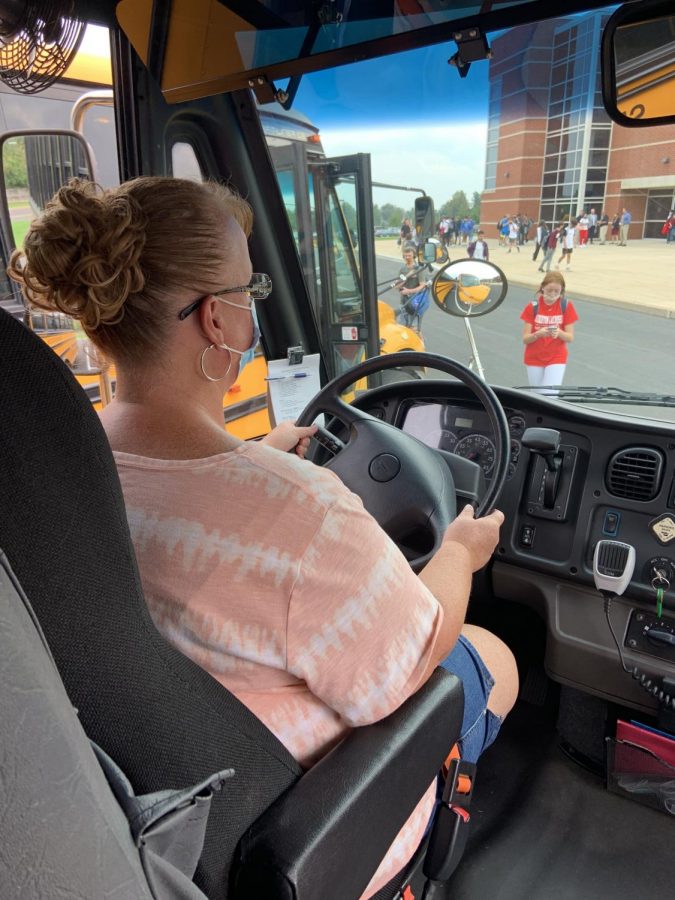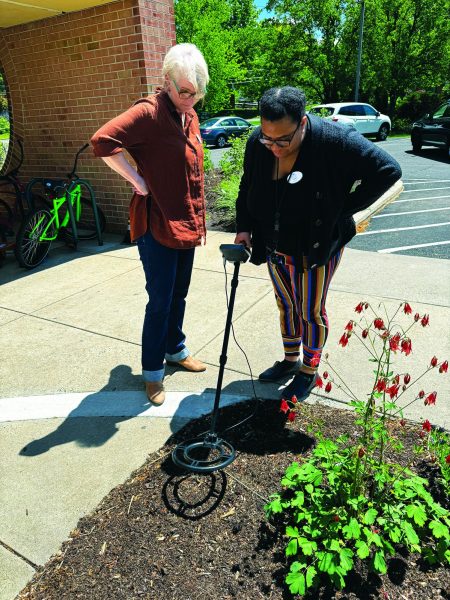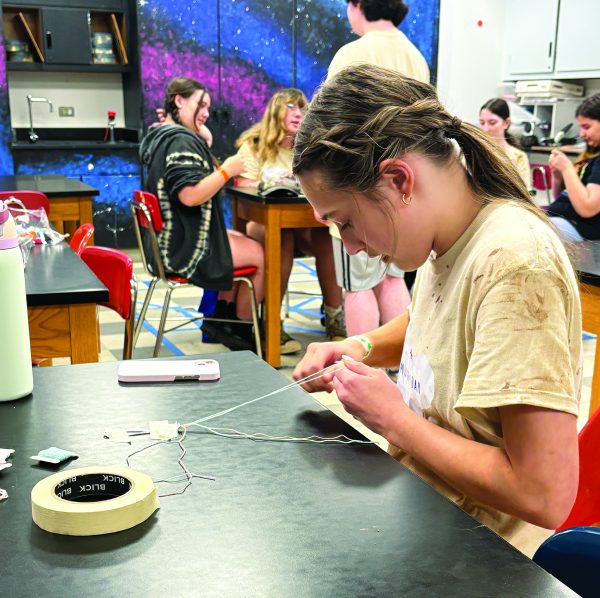Districts battle bus driver shortage
By cross-training employees and participating in more programs, school bus companies are managing bus driver shortages. Changes in the past few years have made it challenging for companies to adapt.
Arrowhead photo by Amanda Yang
Hop on board…Waiting for students in the high school parking lot, bus driver Gwen Landes prepares the bus for departure.
Due to the COVID-19 pandemic and the change in the job market, The Souderton Area School District and surrounding districts are facing a shortage of school bus drivers.
During the past two years, the COVID-19 pandemic changed the learning environment for students.
Numerous students went virtual for the majority of 2020, but many returned back to in person school this year.
Still, bus drivers are feeling the effect of the temporary shut down.
According to Transportation Services Inc (TSI) vice president Glenn Godshall, many bus driver employees got laid off in March of 2020 due to the pandemic causing a switch to virtual learning.
Fortunately, employees that were laid off during the pandemic were entitled to unemployment benefits and other federal assistance programs.
Godshall said that these benefits helped “sustain our group and brought our workforce back.”
However, some bus drivers decided against collecting unemployment and applied for a new job.
According to Central Bucks Transportation Association president Tom Baker, drivers need to obtain a Certified Driver’s License (CDL) in order to fulfill the requirements of becoming a school bus driver.
However, when a person obtains their CDL, they are legally able to “to drive anything from a dump truck to a Septa bus to a trolley to anything in regards to that line,” Baker said.
This is why a number of school bus drivers decided to get a new job in another transportation department.
Since the bus drivers were also certified to drive other vehicles, many school bus drivers decided to work for companies such as FedEx, UPS and Amazon, whose businesses were booming amid the pandemic because of the increasing popularity in delivery.
According to a New York Times article, the “high volume of orders” during the pandemic allowed Amazon to operate much more efficiently.
Delivery drivers were able to make more stops on the same route, and spend less time driving in between customers.
This improvement led to a 220% increase in profit, which attracted many new employees.
Adding to the increased workforce in delivery sectors, there has also been an increase in the number of part-time jobs available across the country.
“Some business models went away from full time and started models that had people with 32 hours or 36 hours,” Godshall said, “and they treated them as part time jobs without benefits.”
In other words, people who would usually turn to the school busing industry for a part time job now had a much wider range of part time jobs to choose from that don’t start “at 6:30 in the morning,” Godshall said.
The pandemic has also spurred some concerns among older bus drivers.
According to Baker, many bus drivers are those who are either retired or those who have left their careers and want to try something new.
Therefore, since the pandemic added an element of risk to the job, many school bus driver candidates who fell into the high-risk category were losing interest.
“If you’re older and you are now thinking about getting into an enclosed vehicle with approximately 50% of your students unvaccinated,” Baker said, “that’s scary for some drivers.”
Due to the shortage of bus drivers, Godshall along with the management team have had to adjust to the lower number of staff.
According to Godshall, many employees at TSI have been “cross-trained” to have the skills for multiple jobs.
Additionally, according to Souderton Area bus driver Gwen Landes, some members of the garage team along with employees working in the office who have their CDL have stepped up to the role of school bus drivers.
On top of that, TSI has engaged in more programs recently to bring attention to the shortage of bus drivers.
One strategy implemented is the concept of benefits.
“We have a program where the person, if they come fully licensed, [gets] a sign-on bonus of $2,000,” Godshall said.
TSI also implemented referral bonuses that encouraged employees to recruit friends and neighbors to become bus drivers.
Recently, New York Governor Kathy Hochul also announced a plan to relieve the shortage of bus drivers in the United States.
She plans to expand CDL testing opportunities and reach out to hundreds of thousands of license holders in the U.S.
According to Hochul, public health officials have “moved mountains” to get students back in school, and “we are leaving no stone unturned” to provide transportation for students to and from school.
Baker said Hochul’s plan to contact licensed drivers will “get drivers in the seats faster.”
However, in the long run, companies need to make the job attractive in terms of wages. “While some school districts have the ability to do that, other school districts are financially strapped,” Baker said. That’s where school districts need to get more creative in order to implement a long-term fix.”







